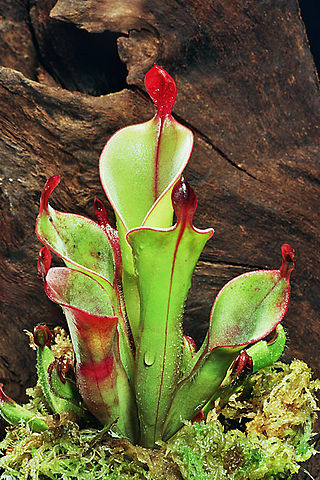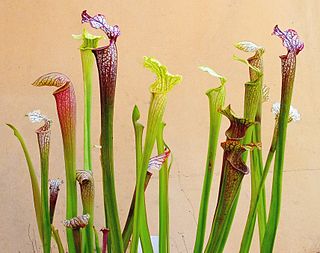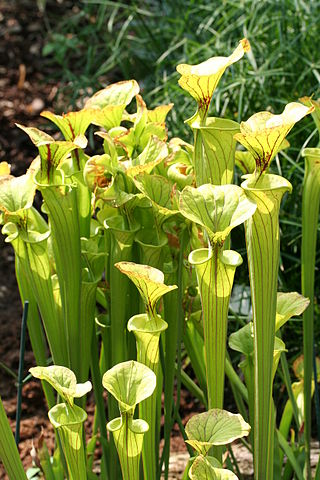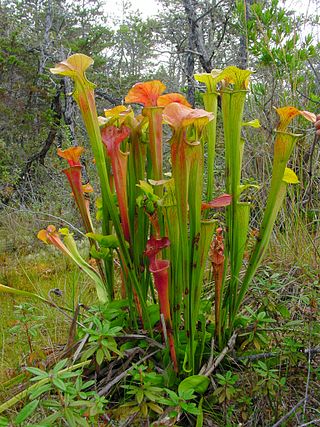
Sarraceniaceae are a family of pitcher plants, belonging to order Ericales.

Sarracenia is a genus comprising 8 to 11 species of North American pitcher plants, commonly called trumpet pitchers. The genus belongs to the family Sarraceniaceae, which also contain the closely allied genera Darlingtonia and Heliamphora.

Sarracenia flava, the yellow pitcherplant, is a carnivorous plant in the family Sarraceniaceae. Like all the Sarraceniaceae, it is native to the New World. Its range extends from southern Alabama, through Florida and Georgia, to the coastal plains of southern Virginia, North Carolina and South Carolina. Populations also exist in the Piedmont, Mendocino County, California and mountains of North Carolina.

Sarracenia purpurea, the purple pitcher plant, northern pitcher plant, turtle socks, or side-saddle flower, is a carnivorous plant in the family Sarraceniaceae.

The Carnivorous Plant Newsletter is the official publication of the International Carnivorous Plant Society (ICPS), the largest such organization in the world. It is headquartered in Walnut Creek, California.

Sarracenia rubra, also known as the sweet or purple pitcher plant, is a carnivorous plant in the genus Sarracenia. Like all Sarracenia, it is native to the New World. Its range extends from southern Mississippi, through southern Alabama, the Florida panhandle and Georgia, to the coastal plains of North Carolina and South Carolina.

Sarracenia oreophila, also known as the green pitcherplant, is a carnivorous plant in the genus Sarracenia. It has highly modified leaves in the form of pitchers that act as pitfall traps for prey. The narrow pitcher leaves are tapered tubes that rise up to 75 centimetres (30 in) from the ground, with a mouth 6 to 10 centimetres in circumference Like all the Sarracenia, it is native to North America. Sarracenia oreophila is the most endangered of all Sarracenia species, its range limited to a handful of sites in northern Alabama, North Carolina, Georgia, and—historically—Tennessee.

Sarracenia alata, also known as yellow trumpets, pale pitcher plant or pale trumpet, is a carnivorous plant in the genus Sarracenia. Specifically, S. alata is an endemic species to North America; it is native to the southeastern regions of the United States, including parts of the Gulf Coast states.

Sarracenia leucophylla, also known as the crimson pitcherplant, purple trumpet-leaf or white pitcherplant, is a carnivorous plant in the genus Sarracenia.

Sarracenia minor, also known as the hooded pitcherplant, is a perennial, terrestrial, rhizomatous, herbaceous, carnivorous plant in the genus Sarracenia. Like all the Sarracenia, it is native to North America.

Carnivorous plants are plants that derive some or most of their nutrients from trapping and consuming animals or protozoans, typically insects and other arthropods, and occasionally small mammals and birds. They still generate all of their energy from photosynthesis. They have adapted to grow in places where the soil is thin or poor in nutrients, especially nitrogen, such as acidic bogs. They can be found on all continents except Antarctica, as well as many Pacific islands. In 1875, Charles Darwin published Insectivorous Plants, the first treatise to recognize the significance of carnivory in plants, describing years of painstaking research.
Exyra fax, the pitcher plant moth, is a moth of the family Noctuidae. It is mainly found on the Atlantic Coastal Plain and Great Lakes region of eastern North America (from Manitoba through Michigan to Nova Scotia and Maine south to Georgia. The species is listed as threatened in Connecticut.
Exyra ridingsii is a moth of the family Noctuidae. It is found from North Carolina to Florida and Alabama.

Ponometia semiflava, the half-yellow or yellow-cloaked midget, is a moth of the family Noctuidae. The species was first described by Achille Guenée in 1852. It is found in North America from New York and New England to Florida, west to Arizona, north to British Columbia and Manitoba.

Sarracenia jonesii is a species of pitcher plant endemic to seepage bogs in the appalachian mountains of North Carolina and South Carolina. It is currently only found in ten locations: 4 in North Carolina and 6 in South Carolina. S. jonesii is listed as endangered by the US federal government.

Choristoneura parallela, the parallel-banded leafroller moth, is a species of moth of the family Tortricidae. It is found in North America, where it has been recorded from California, Florida, Georgia, Indiana, Kentucky, Maine, Maryland, Michigan, Mississippi, New Jersey, North Carolina, Ohio, Oklahoma, Quebec, Saskatchewan, South Carolina, Tennessee, Virginia and West Virginia.

Endothenia hebesana, the verbena bud moth, is a species of moth of the family Tortricidae. It is found in North America, where it has been recorded from Massachusetts, New York, New Jersey, Pennsylvania, Maryland, Virginia, North Carolina, Florida, Texas, Ohio, Indiana, Missouri, California, British Columbia, Alberta, Manitoba and Ontario. The habitat consists of black spruce-sphagnum bogs.

The North American Sarracenia Conservancy (NASC) is a 501(c)(3) non-profit organization dedicated to habitat conservation. Founded in 2005, the Conservancy was granted tax-exempt status in January 2009. The main focus of the Conservancy is the conservation and preservation of the natural habitats and genetic diversity of the Sarracenia pitcher plants. Sarracenia is a genus of carnivorous plant that trap prey in tube-shaped, hollow leaves, which in some species hold rain water. Species range from the southeastern United States, up the coastal plain, and into the Great Lakes and Canada. Within their range the plants naturally occur in sphagnum bogs, swamps, fens, and flooded plains.

The North American continent is home to a wide variety of carnivorous plant species. Species from seven genera are native to the continent, and three of these genera are found nowhere else on the planet.
Papaipema appassionata, the pitcher plant borer, is a species of moth described by Leon F. Harvey in 1876. It is native to North America, where it has been recorded from Florida, Maine, Maryland, Massachusetts, Michigan, Minnesota, New Brunswick, Quebec, Rhode Island, South Carolina and Wisconsin. It is listed as threatened in the US state of Connecticut.

















